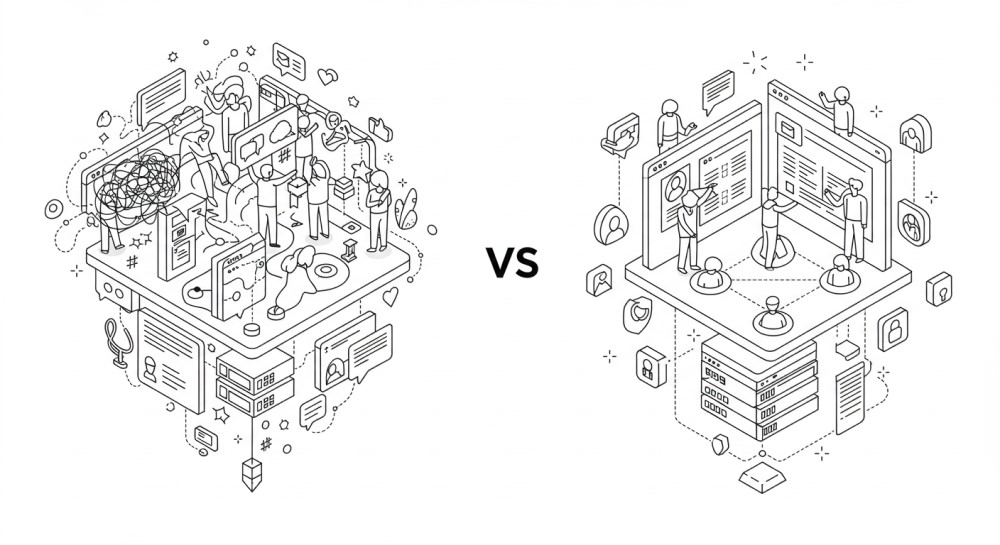
An endless scroll of likes and quick comments can keep people momentarily engaged, but it rarely fosters the kind of deep connections that result in long-term loyalty. Dedicated digital communities—intimate spaces where members feel valued—are fundamentally different. Beyond delivering fresh content, they address the psychological needs that truly encourage individuals to engage on a deeper level, including belonging, self-expression, mutual trust, and real-world collaboration.
Whether your community centres on a professional network, a specialised hobby, or a social cause, achieving enduring success requires more than a simple platform. By recognising why people come together online and how they build genuine bonds, you create an experience that outlasts fleeting social media trends.
This includes offering activities that blend digital and offline interactions, encouraging mentorship, and cultivating sincere relationships rather than superficial metrics. In the sections that follow, we’ll look at the psychology of online communities, exploring how to build spaces where members don’t just drop in—they stay.
1. The Human Need for Belonging: Creating Spaces for Real Connection

For centuries, we’ve met in clubs, gatherings, and social circles to satisfy our innate need for belonging. In the digital realm, replicating this sense of real community requires a focus that mass social networks often lack. Instead of getting lost in a feed of unconnected posts, members of a well-structured online group can unite around shared interests or goals, forming a collective identity that extends beyond typical “likes” or comments.
- Inclusive culture: Your community guidelines should emphasise mutual respect and constructive conversation. When people trust that their perspectives will be heard—without hostility or belittlement—they’re more likely to participate and forge deeper connections.
- Shared purpose: Whether it’s learning a new skill, supporting a movement, or celebrating a hobby, having a unifying aim enhances community stickiness. Regular online discussions and offline meetups—like workshops, local gatherings, or group dinners—further strengthen this common ground, transforming digital acquaintances into real-world friends.
As members recognise they’re part of something bigger, they invest more time and emotion into the group. This drives not only loyalty but also an eagerness to welcome newcomers, perpetuating the cycle of genuine community growth.
2. Identity and Self-Expression: Helping Members Show Their True Selves
Social media encourages quick updates, but often lacks the depth required for meaningful self-expression. Digital communities that truly succeed open the door for members to explore who they are and share it with others who genuinely care.
- Customisable profiles and subgroups: Providing in-depth user profiles or separate channels for niche interests allows people to showcase what makes them unique—be it professional expertise, a creative hobby, or personal experiences.
- Authentic storytelling: By enabling long-form posts, personal journals, or Q&A sessions, you invite members to move beyond surface-level sharing. If someone details the journey of starting a small business, for example, others can connect over similar experiences, leading to more honest, empathetic dialogue.
Encouraging members to bring these digital expressions into real-world settings—like photography clubs, study groups, or volunteering initiatives—deepens the authenticity of those profiles, as actions and engagement speak louder than static images or bios.
3. Genuine Connections vs. Surface-Level Validation

One of the biggest challenges in today’s online world is separating true relationship-building from a quick hit of approval. On large social media platforms, a ‘like’ or quick emoji often substitutes for real conversation. In a dedicated community, however, interaction becomes more thoughtful, consistent, and productive.
- In-depth feedback: Instead of random “hearts,” encourage members to offer detailed insights or constructive critique. This approach not only validates the original poster but also sparks discussions that can branch into new projects or offline meetups.
- Community highlights: Celebrating a member who organises a local event or helps fellow users navigate a tricky problem strengthens collective value. Recognising genuine contributions—like mentoring newcomers or running a webinar—reinforces that this is a place of real substance, not just surface-level praise.
Over time, these more profound forms of acknowledgment create a culture of trust, where people feel motivated to contribute because they know their efforts won’t go unnoticed. In turn, the community develops a more supportive, family-like dynamic that’s rarely found on mainstream social media.
4. Fostering Meaningful Engagement Over Empty Incentives
While some online spaces resort to gimmicky tactics—like flashy badges or constant point-scoring—such features can dilute real interactions if overused. Sincere engagement emerges from genuine interest, collaboration, and mutual learning, rather than competition for the next digital trinket.
- Purpose-driven initiatives: Align community activities with larger goals that members care about, whether it’s raising funds for a local cause, sharing professional opportunities, or engaging in skill-building workshops. When participants see the real-world impact of their involvement, they’re more likely to stick around.
- Recognition with substance: Acknowledge top contributors not merely through digital icons but through responsibilities or privileges that reinforce trust. For instance, a member who consistently shares valuable knowledge could be invited to moderate a forum thread or host an in-person event. This way, rewards deepen social bonds instead of creating a shallow hierarchy.
By prioritising authentic relationships, you ensure members aren’t just chasing status; they’re cultivating friendships and shared experiences that benefit everyone in the long run.
5. The Psychology of Online Communities: The Need for Trust, Safety, and A Holistic Team Approach

Building a thriving digital community involves more than a single community manager posting updates or approving new members. A holistic team—spanning engagement strategy, behavioural psychology, content creation, data analytics, and project management—is essential for shaping a balanced and secure environment.
- Moderation for emotional security: Clear guidelines and proactive moderation reassure members that discussions will remain respectful. Consistent enforcement of policies—such as removing inappropriate posts or mediating disagreements—demonstrates that the platform cares about members’ well-being.
- Expert collaboration: Engagement strategists plan events and campaigns to keep people coming back, behavioural experts advise on healthy group dynamics, data analysts track metrics to refine the experience, and project managers coordinate multiple ongoing initiatives. This concerted effort ensures no single person bears the entire load, preventing burnout and oversight.
Ultimately, a safe, well-run environment is the bedrock of genuine connections. When people feel secure in sharing their thoughts or vulnerabilities, real friendships form—both behind the screen and at community-organised gatherings.
6. More Than Content: Events, Subgroups, and Mentorship
Contrary to popular belief, digital communities aren’t just about posting content. Some of the deepest connections form around hands-on collaboration, offline activities, and the practical support members can offer each other.
- Events (online and offline): Virtual lectures or live chat sessions can spark instant engagement, while in-person conferences, workshops, or group meetups consolidate those digital friendships. When members who’ve chatted for months finally meet in real life, the relationship tends to solidify and expand.
- Subgroups: Fostering smaller clusters—like “regional tech hubs” or “support circles for working parents”—promotes intimacy and a chance for members to dive deeper into specific subjects. This not only widens the community’s scope but also strengthens ties among like-minded individuals.
- Mentorship and job support: Whether newcomers need to learn the ropes or experienced members aim to share career advice, structured mentorship schemes cultivate goodwill. They also underscore the community’s commitment to personal growth, showing that it’s a space for genuine value rather than superficial talk.
These avenues encourage people to invest more time, effort, and passion in the community. When practical help and face-to-face connections are part of the package, membership evolves from a casual pastime to a meaningful life element.
7. Rituals and Shared Experiences: The Glue of Community Culture

Rituals—large or small—tie members to the community’s identity. Whether it’s a simple welcome process for newcomers, a monthly roundup of success stories, or an annual celebration, these collective experiences enhance group unity.
- Consistent traditions: Weekly themed discussions or monthly online socials build anticipation. Over time, they become anchor points, reassuring members that the community is active and committed to shared growth.
- Personalised welcomes: A “buddy system” for new entrants or a custom introduction thread helps people integrate quickly. When members receive a warm reception and guidance, they’re more motivated to return the favour to future arrivals.
- Annual or seasonal gatherings: Whether hosted online or in person, bigger events are cornerstones that members look forward to. Meeting up at a festival, conference, or retreat can reshape digital acquaintances into lasting friendships, further reinforcing the community’s bond.
As these rituals accumulate, they create a tapestry of shared memories, jokes, and traditions—solidifying the sense that members aren’t just part of a forum, but an evolving family.
8. Designing a Community with Genuine Connections at Its Core
How do you tie all these elements together to create a vibrant, enduring digital community?
- Start with a mission: Clearly define your community’s purpose—be it peer learning, social advocacy, professional networking, or something else. Members who understand the “why” behind your space are more likely to engage deeply.
- Commit to inclusive design: Offer intuitive navigation and group channels so people can find like-minded peers. Encourage smaller subgroups that let members form closer connections based on location, interests, or career stages.
- Assemble a multidisciplinary team: A single community manager rarely suffices. Pull in content creators for fresh material, engagement specialists for campaigns, data analysts to measure success, and behavioural experts to maintain positive cultural norms.
- Foster emotional security: Demonstrate a commitment to respectful dialogue through clear policies and consistent moderation. People who feel safe share more openly, building trust and stronger relationships.
- Evolve with feedback: Survey members, watch engagement trends, and adapt your events or subgroup focuses accordingly. By pivoting based on real input, you ensure the community remains relevant, exciting, and rewarding for all.
Implementing these steps nurtures a space where genuine connections flourish—where members don’t just exchange posts, but truly support and learn from one another.
Conclusion – Creating Digital Communities That Truly Connect

Standing out in a world of short attention spans requires going beyond one-click reactions and ephemeral engagements. Genuine connections arise when a digital community addresses core psychological needs—belonging, authenticity, trust, and purposeful engagement. This vision transcends the superficial allure of vanity metrics, instead highlighting offline collaborations, mentorship programmes, subgroups, and real-world events.
Moreover, sustaining such a community demands more than occasional updates from a single manager. A holistic team spanning diverse specialisms—marketing, data analytics, behaviour analysis, engagement strategy, and more—lays the groundwork for an environment where members feel confident investing their time and energy. By aligning strategic design with honest, empathetic human interaction, you create a platform where people forge friendships, share knowledge, and progress together in meaningful ways.
